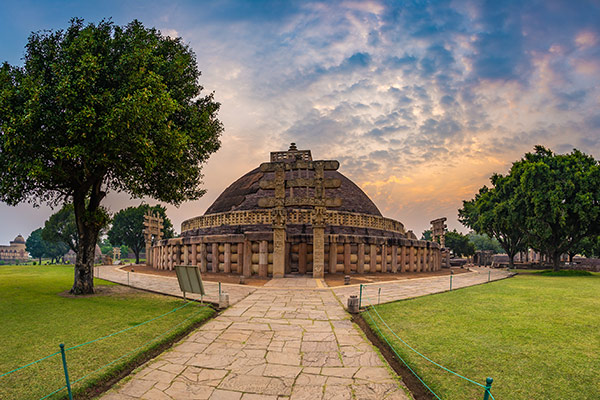Madhya Pradesh, often called the ‘Heart of India’ owing to its central location, delights tourists with its rich biodiversity, exquisite architectural marvels, and cultural heritage. The state boasts of three UNESCO World Heritage Sites and is also noted for being home to four of the greatest Indian classical music gharanas. Its innumerable monuments narrate the tales of the erstwhile Maharajas while the sanctuaries offer a chance to see the majestic Tiger in his habitat.
Tourism is a major industry in Madhya Pradesh, and the state has won the ‘Best Tourism State’ National Award for three consecutive years (2015-2017). In 2017, it also bagged the ‘Best State for Adventure Tourism’ and ‘Most Innovative Tourist Product’ awards, among many others.
There are many accommodation facilities across the state to cater to the domestic and foreign tourists coming here including heritage and luxury resorts, budget hotels, and homestays.
Madhya Pradesh Tourism Information
| Capital | Bhopal |
| Official Language | Hindi |
| Area | 308,252 square kilometer |
| Main Cities | Indore, Bhopal, Gwalior, Jabalpur, Ujjain, Sagar, Satna, Ratlam, Rewa |
| Status | State |
| Official Tourism Website | http://www.mptourism.com/ |
| Nicknames | Heart of India |
| Major Railheads | Bhopal Junction, Bhopal Habibganj, Gwalior Junction, Indore Junction, Jabalpur Junction, Ratlam Junction, Ujjain Junction, Itarsi Junction, Khandwa Junction, Balaghat Junction, Katni Junction, Dewas Junction, Satna Junction, etc. |
| Airport | Raja Bhoj International Airport (Bhopal), Devi Ahilya Bai Holkar Airport (Indore), Rajmata Vijaya Raje Scindia Air Terminal (Gwalior), Dumna Airport (Jabalpur), Khajuraho Airport |
History of Madhya Pradesh
History of Madhya Pradesh | Madhya Pradesh Tourism
Archeological evidence from the Narmada Valley dates the history of this region back to the Middle Pleistocene era. The Mauryas and Guptas were two of the most prominent dynasties that ruled over the region before the Mughals. In the 18th century, the Marathas had control over most parts of Madhya Pradesh along with the Scindias of Gwalior, Holkars of Indore and Bhonsles of Nagpur. However, after the Third Anglo-Maratha War, the region came under the British and in 1861, became a part of the Central Provinces.
Post-independence, Madhya Pradesh was created as a state in 1950 with Nagpur as its capital. In 1956, the state was expanded to include Madhya Bharat, Bhopal and Vindhya Pradesh while the Vidarbha region was made part of the erstwhile state of Bombay; Bhopal became the new capital of the state. In 2000, the state was divided into Madhya Pradesh and Chhattisgarh.
Geography and Climate
Madhya Pradesh is located in central India along the River Narmada. In addition to this, Betwa, Chambal and Shipra are some of the major rivers flowing through the state. The landscape of Madhya Pradesh is also dominated by Vindhya and Satpura mountain ranges. On the map, the state shares its borders with Gujarat in the west, Rajasthan in the northwest, Uttar Pradesh in the northeast, Chhattisgarh in the east and Maharashtra in the south.
Madhya Pradesh has a subtropical climate with hot and dry summers and cool winters. The best time to visit Madhya Pradesh is between October and March. Monsoons are also a good time to visit the state’s waterfalls and the beautiful hill station of Pachmarhi.
Places to Visit in Madhya Pradesh
Places to visit in Madhya Pradesh | Madhya Pradesh Tourism
- UNESCO World Heritage Sites: Khajuraho Group of Monuments, Buddhist Monuments at Sanchi and Rock Shelters of Bhimbetka
- Other Historical Places: Gwalior Fort, Rajwada Palace, Jai Vilas Palace, Lal Bagh Palace, Udayagiri Caves, Kirti Stambh, Hindola Mahal, Madan Mahal Fort, Orchha Fort Complex
- Religious Places: Omkareshwar Temple, Mahakaleshwar Jyotirlinga, Kandariya Mahadev Temple, Annapurna Temple, Shri Kshetra Gommatagiri Digambar Jain Temple, Chausath Yogini Temple, Sas Bahu Temple, Taj-ul-Masajid
- Wildlife Sanctuaries: Kanha Tiger Reserve, Bandhavgarh National Park, Panna National Park, Satpura Tiger Reserve, Van Vihar National Park, Madhav National Park, National Chambal Sanctuary
- Museums: Indore Museum, Indira Gandhi Rashtriya Manav Sangrahalaya, H.H Maharaja Sir Jiwaji Rao Scindia Museum
- Waterfalls: Dhuandhar Falls, Bee Falls, Patalpani Waterfall, Tincha Falls, Raneh Falls, Pandav Falls, Bahuti Falls, Rajat Pratap Falls, Keoti Falls, Pawa Falls
- Lakes: Lower Lake, Upper Lake, Badi Jheel Lake, Sakhya Sagar Lake, Sirpur Lake
Cuisine of Madhya Pradesh
Cuisine of Madhya Pradesh | Madhya Pradesh Tourism
The cuisine of Madhya Pradesh consists of a number of traditional dishes prepared using wheat – the staple food of the state. Some of the well-known delicacies from Madhya Pradesh include Poha, Dal Bafla, Kebabs, Bhutte Ka Kees, Palak Puri, Bhopali Gosht Korma, Chakki Ki Shak, Sukhi Sabudana, Khasta Kachori Kuduk, Papad Ki Sabzi, Kopra Patties and Laapsi. The region is known for iconic desserts like Malpua, Imarti, Shahi Shikanji and Mawa Bati and local drink, Mahua.
Shopping in Madhya Pradesh
Shopping in Madhya Pradesh | Madhya Pradesh Tourism
Madhya Pradesh is known for its traditional handicrafts. From street markets to air-conditioned malls, there are plenty of places to indulge in retail therapy. Some of the best souvenirs to take home with you include:
- Tribal jewelry
- Mandana paintings
- Pithora paintings
- Bamboo and cane work
- Metal crafts
- Dhurries
- Stone carvings
- Chanderi sarees
- Terracotta
- Papier mache
- Carved wood curios
- Dhokra
- Jute craft
- Gond paintings
- Leather toys
- Zardozi embroidery
- Lac bangles
Things to Do in Madhya Pradesh
- Explore the temples of Khajuraho
- Trek up the hills
- Take a boat ride down the Narmada
- Indulge in water sports
- Ride a cable car
- Explore the caves
- Experience the thrill of rafting
- Camp under the stars
- Ride a hot air balloon
- Savor street foods
- Attend a music and dance festival
- Go on a wildlife safari

